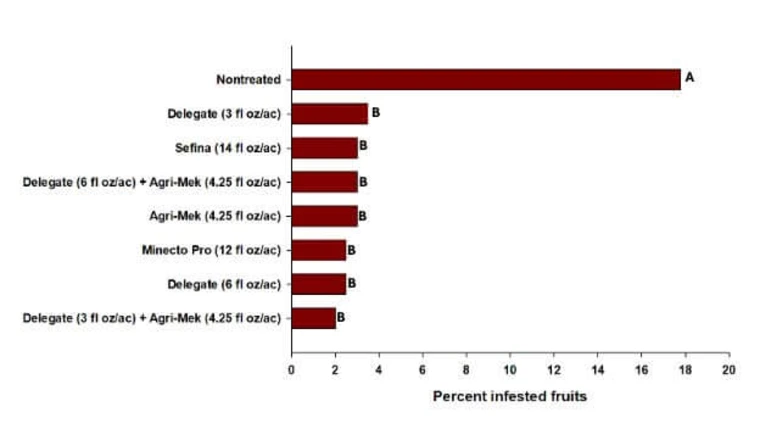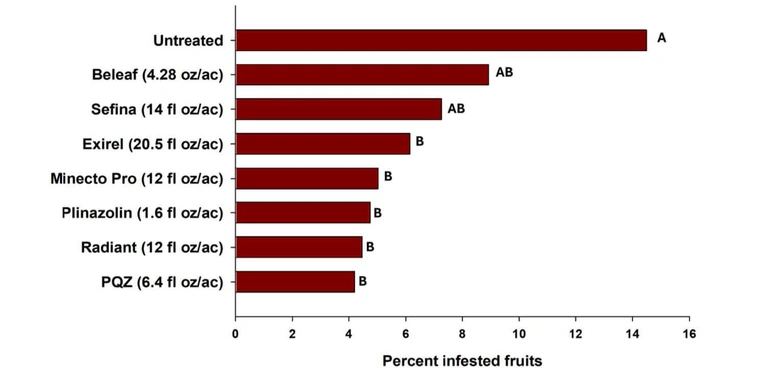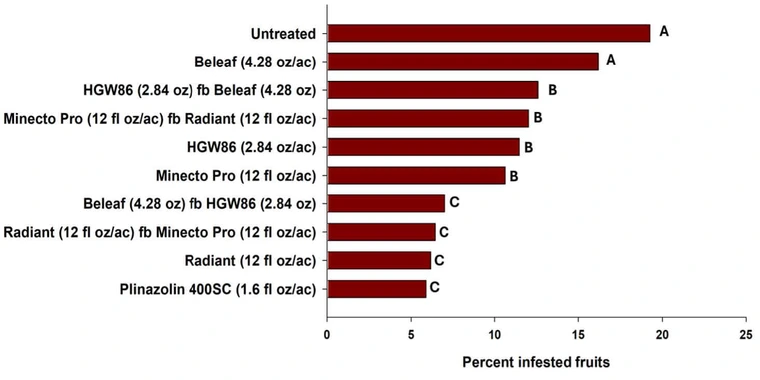Citrus has historically been among the most important crops grown in Arizona. For the 2023-2024 season, the Arizona citrus harvest was valued at approximately $29 million (USDA National Agricultural Statistics Service 2024). Several arthropod pests can attack citrus crops in Arizona, with citrus thrips, Scirtothrips citri, being the most economically damaging insect pest. The pest damages the fruit by puncturing the epidermal cells, causing scabby, grayish, or silvery scars on the rind. This damage is only cosmetic, affecting the appearance of the fruit, but may result in a reduced quality rating. When severe, thrips damage may render the fruit unsuitable for the fresh market (Kerns et al. 2001, Bethke et al. 2014).
Biology
Adult citrus thrips are small and orange to yellow in color. Like all thrips, the citrus thrips has fringed wings. The size of a female citrus thrips ranges from 0.6 to 0.88 mm. Males are shorter and narrower than females. The eggs of citrus thrips measure approximately 0.2 mm and are oviposited under the cuticle of new leaves, stems, and fruit. Most of these eggs are laid in the fall and are often laid simultaneously with the fall growth flush of citrus; these eggs will then hatch in March, around the time of the new spring growth. During the warmest time of the year, the eggs typically hatch in approximately 6 to 8 days. Citrus thrips larvae undergo four instars. The first and second instar larvae are the two actively feeding nymphal stages. The third and fourth instars are non-feeding stages, referred to as prepupa and pupa, respectively. At these stages, they disperse on the ground, often among the decomposing leaves under the trees or in tree crevices, where they complete their development. The first instar larvae feed on tender leaves and fruits, especially under the sepals of young fruit. The first instar of citrus thrips is clear in color with red eyes and is approximately 0.4 mm long. The second instar is yellowish and measures approximately 0.9 mm long. The prepupa measures approximately 0.6 to 0.7 mm in length. The pupa is yellowish-green and measures approximately 0.7 mm in length. The temperature range for effective development of citrus thrips is 70 – 95°F. Under ideal conditions, citrus thrips can produce 8 to 12 generations per year, completing a single generation in approximately 15 days (Kerns et al. 2001, Gautam et al. 2020, Tanigoshi et al. 1982).
It is important to note that other species of thrips (western flower thrips, Frankliniella occidentalis, and onion thrips, Thrips tabaci) can be found on citrus in Arizona, but they do not injure either the citrus plants or the fruit, and thus do not require treatment. The western flower thrips can be very common and in high numbers during bloom, on the flowers, small fruit, and flush growth. Therefore, one must be careful to avoid confusing western flower thrips with citrus thrips (Kerns et al. 2001).
Differentiating from western flow thrips and onion thrips
Larvae of citrus thrips are clear, yellow, or light orange (Fig. 1 & 2). They occur mostly on leaves and fruit, especially under the calyx. The second instar of citrus thrips is stout with a bulging abdomen (Fig. 2). Western flower thrips larvae can also be whitish, yellow, or orangish, but they can be differentiated based on their elongated abdomen (Fig. 3). Western flower thrips occur on citrus at bloom time and primarily on or near blossoms (UC IPM 2016). The onion thrips larvae are white to pale yellow with an elongated and slender body. Their eyes are dark. They resemble a wingless adult (Fig.6; Alston and Drost 2008).
Distribution and host range
Citrus thrips is native to the southwestern United States and northwestern Mexico. Citrus thrips is polyphagous, meaning that it can feed on several plant species including cultivated plants such as all types of citrus, alfalfa, cotton, rose, avocado, date, mango, blueberries, and grape; and non-cultivated plants including California sumac, live oak, mesquite, willow, California pepper tree, buckthorn, creosote bush, chamise, fir, magnolia tree, and California laurel (Kerns et al. 2001, Gautam et al. 2020, Tanigoshi et al. 1982).
Damage
Citrus thrips damage on citrus fruit is mainly characterized by grayish or silvery scars on the rind (Fig. 7). Damage to citrus fruit is mostly caused by second instar larvae feeding under the sepals of forming fruits. When significant, citrus thrips damage may reduce fruit grade or render it unsuitable for the fresh market. Another type of scarring may occur at the stylar or bottom end of the fruit (Fig. 8). This type of scarring is more common in mandarin varieties. Citrus fruits are most susceptible when they are small (between petal fall to 1.5 inches in diameter). Once the fruits reach 1.5 inches in diameter, the rind becomes too hard for the thrips to pierce. Citrus thrips also feed on and damage citrus tree leaves (Fig. 9). However, feeding damage on leaves does not warrant control action. Citrus trees can withstand a substantial amount of leaf damage and continue to grow and produce well (Kerns et al. 2001, Gautam et al. 2020).
Management
Scouting
- Starting at petal fall, check young, healthy, dark green fruits from outside, sunny branches for immature thrips.
- Fifty to a hundred fruits may have to be inspected to obtain an adequate estimate of the citrus thrips population.
- Do not collect samples from border rows. Skip the first 2-3 outermost rows.
- Samples should be taken from various locations throughout the grove and from all four quadrants of each sample tree.
- Look for thrips on the stem end of the fruit and under the calyx. The use of a 10X magnification hand lens can facilitate the identification of citrus thrips and help observers differentiate between adults and nymphs.
- Count fruit as infested only if it has one or more wingless first- or second-instar nymphs (ignore pupae and adults).
- Record the total number of fruit infested with immature citrus thrips and calculate the percentage of infested fruits. The recommended action threshold for citrus thrips control in citrus in Arizona is when 10% or more fruits are infested with citrus thrips larvae.
- Monitor the grove at least twice per week after petal fall, and continue monitoring until 70-90% of all fruit have passed the susceptible stage.
- Fruit measuring 1.5 inches in diameter or bigger is no longer susceptible to citrus thrips injury and should be discounted from the sampling process.
- Yellow sticky cards can be used to monitor citrus thrips activity, but visual inspection and counts should be done for insecticide treatment decision-making.
Chemical control
It is essential to minimize unnecessary insecticide applications by applying an insecticide based on the 10% infested fruit threshold (Calvin et al. 2024). Citrus thrips can develop resistance to insecticides that are frequently used to control them. Hence, reducing the frequency of insecticide application and rotating insecticides with different modes of action will reduce the selection pressure and delay the development of resistance. There are several cases where citrus thrips have developed resistance to insecticides such as beta-cyfluthrin (Baythroid) and spinetoram (Delegate) in San Joaquin Valley, California, and hydrochloride (Carzol) in both San Joaquin and Coachella valleys, California (Gautam et al. 2020).
Recent research trials conducted at the Yuma Agricultural Center, Mesa Farm, showed Radiant/Delegate, Sefina, Minecto Pro, Exirel, Plinazolin, PQZ, Agri-Mek, and a tank mix of Delegate + Agri-Mek, can provide measurable control of citrus thrips (Table 1; Fig. 10, 11, 12). Radiant and Delegate have the same active ingredient (Spinetoram), but each has a different formulation. Delegate is registered for citrus, but Radiant is not. Plinazolin is a new active ingredient classified in the IRAC Group 30. Upon EPA registration, it is anticipated to be available under the brand name Zivalgo™ for citrus crops. With several insecticides from different groups available for thrips control, there are multiple options for insecticide rotation. It is essential to rotate as much as possible to delay the development of insecticide resistance in citrus thrips populations in Arizona’s citrus-growing regions.
Common Name | Active Ingredient | IRAC Group | Impact on Beneficial Insects |
|---|---|---|---|
Agri-Mek | 6 | Toxic to predatory mites | |
Beleaf 50 SG | Flonicamid | 29 | Minimal effect on most natural enemies |
Delegate/Radiant | Spinetoram | 5 | Toxic to most natural enemies |
Exirel | Cyantraniliprole | 28 | Minimal effect on most natural enemies |
| HGW86 (new Exirel formulation) | Cyantraniliprole | 28 | Minimal effect on most natural enemies |
Minecto Pro | Cyantraniliprole + Abamectin | 28+6 | Toxic to predatory mites but has minimal effect on most natural enemies |
Plinazolin | Isocycloseram | 30 | Toxic to predatory mites |
PQZ | Pyrifluquinazon | 9B | Minimal effect on most natural enemies |
Sefina | Afidopyropen | 9D | Toxic to parasitic wasps |

Figure 10. Seasonal means of percent infested fruits as affected by two insecticide applications at a 3-week interval, Spring 2022. Spray volume = 100 gallons per acre. The surfactant Gavicide green 415 (0.5% v/v) was included in all treatments. Bars with the same letter are not significantly different (P > 0.05).

Figure 11. Seasonal means of percent infested fruits as affected by two insecticide applications at a 2-week interval, Spring 2024. Spray volume = 100 gallons per acre. The surfactant Gavicide green 415 (0.5% v/v) was included in all treatments. Bars with the same letter are not significantly different (P > 0.05).

Figure 12. Seasonal means of percent infested fruits as affected by two insecticide applications at a 2-week interval, spring 2025. Plots treated with Plinazolin received only one application. Spray volume = 100 gallons per acre. The surfactant Gavicide green 415 (0.5% v/v) as included in all treatments. Bars with the same letter are not significantly different (P > 0.05).
Biological control
Beneficial arthropods, including predatory mites, spiders, lacewings, and minute pirate bugs, can help to keep citrus thrips in check, especially when the thrips pressure is low or moderate. When citrus thrips pressure is high, natural enemies alone are insufficient to keep the population below damaging levels. When insecticides with minimal impact on natural enemies (Table 1) are used, the number of insecticide applications needed to control the pest is significantly reduced. Thus, we highly recommend the use of these selective insecticides.
Cultural control
To my knowledge, there are no currently developed cultural control methods for citrus thrips. However, since citrus thrips have a broad range of host plants, it is important to properly manage weeds in and around your groves to prevent harboring the pest and disrupting its life cycle.
Summary
Citrus thrips can reduce marketable yields of citrus by impacting the quality of the fruit. It is important to monitor the pest carefully and trigger control measures when the 10% action threshold is reached or exceeded. Remember to rotate insecticides as often as possible. Several effective insecticides with distinct modes of action are available for citrus thrips control, making it very suitable for proper insecticide rotation when targeting the pest.
References
Bethke, J. A. S. H. Dreistadt, and L. G. Varela. 2014. Thrips. https://ipm.ucanr.edu/PMG/PESTNOTES/pn7429.html
Calvin, W., L. C. Chavez, and J. C. Palumbo. 2024. Efficacy of Alternative Insecticides for Citrus Thrips Control on Lemons in Arizona, 2024. Arthropod Management Tests. https://doi.org/10.1093/amt/tsae117
Gautam, S. G. E. E. Grafton-Cardwell, J. G. Morse, D. R. Haviland, B. A. Faber, M. J. R. Rivera, et al. 2020. Citrus Pest Management Guidelines. UC ANR Extension Publication 3441. https://ipm.ucanr.edu/agriculture/citrus/citrusthrips/#gsc.tab=0
Kerns, D., G. Wright, and J. Loghry. 2001. Citrus Thrips (Scirtothrips citri). UA Extension Publication. http://cals.arizona.edu/crops/citrus/insects/citrusinsect.html
Tanigoshi, Lynell K., and Joyce Y. Nishio-Wong. 1982. Citrus thrips: Biology, Ecology, and Control. U.S. Department of Agriculture, Technical Bulletin n. 1668, 17p. 6- Alston, D. and D. Drost. 2008. Onion Thrips (Thrips tabaci). https://extension.usu.edu/planthealth/research/onionthrips
USDA National Agricultural Statistics Service 2024. Citrus Fruits 2024 Summary.
UC IPM. 2016. Citrus Thrips and Western Flower Thrips. https://ipm.ucanr.edu/PMG/C107/m107ppcitrusthrips.html










